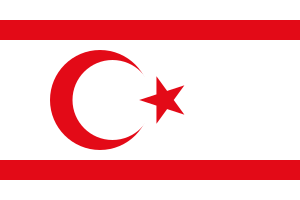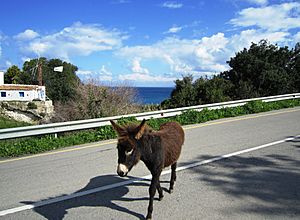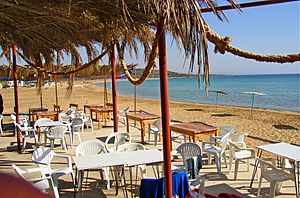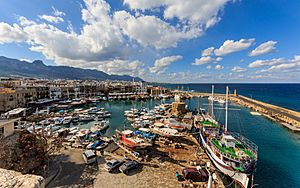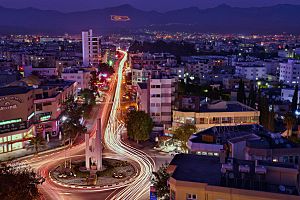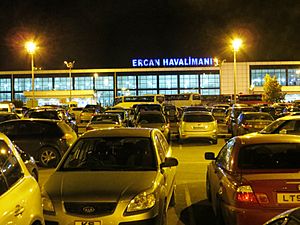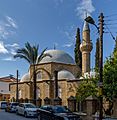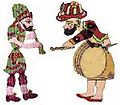Northern Cyprus facts for kids
Quick facts for kids
Turkish Republic of Northern Cyprus
Kuzey Kıbrıs Türk Cumhuriyeti (Turkish)
|
|
|---|---|
|
|
|
 |
|
| Status | Recognised only by Turkey |
| Capital and largest city
|
North Nicosia 35°11′N 33°22′E / 35.183°N 33.367°E |
| Official languages | Turkish |
| Demonym(s) | Turkish Cypriot |
| Government | Unitary semi-presidential republic |
| Mustafa Akıncı | |
| Tufan Erhürman | |
| Legislature | Assembly of the Republic |
| Independence from the Republic of Cyprus | |
|
• Proclaimed
|
15 November 1983 |
| Area | |
|
• Total
|
3,355 km2 (1,295 sq mi) (unranked) |
|
• Water (%)
|
2.7 |
| Population | |
|
• 2017 estimate
|
326,000 |
|
• 2011 census
|
286,257 |
|
• Density
|
93/km2 (240.9/sq mi) (117th) |
| GDP (nominal) | 2017 estimate |
|
• Total
|
$3.685 billion |
|
• Per capita
|
$12,702 |
| Currency | Turkish lira TRY) |
| Time zone | EET (UTC+2) |
|
• Summer (DST)
|
UTC+3 (EEST) |
| Driving side | left |
| Calling code | +90 392 |
The Turkish Republic of Northern Cyprus (TRNC) is a country located on the northern part of the island of Cyprus. In Turkish, its name is Kuzey Kıbrıs Türk Cumhuriyeti. It is a self-declared state, meaning most countries do not officially recognize it as an independent nation. Only Turkey recognizes it.
About 300,000 people live here, and it covers an area of 3,335 square kilometers.
Cyprus was once part of the Ottoman Empire from 1570 to 1914. Many Turkish people moved there during this time. After World War I, the British took control of Cyprus. In 1923, Turkey officially gave up its claim to the island. Cyprus then became a British crown colony until 1960.
In 1974, there was a military coup in Cyprus. The Turkish army then intervened. This event caused many Greek and Turkish Cypriots to leave their homes and become refugees in different parts of the island. Later, in 1983, the Turkish Republic of Northern Cyprus was formed.
Leaders have tried to unite the island many times, but they have not been successful. The quality of life in Northern Cyprus is generally lower than in the southern part of the island, which is the Republic of Cyprus. The European Union considers the Republic of Cyprus to be the only official government for the whole island.
Contents
Geography and Landscape
Northern Cyprus covers about one-third of the island, with an area of 3,355 square kilometers (1,295 square miles). To its north, about 75 kilometers (47 miles) away, is Turkey. Syria is about 97 kilometers (60 miles) to the east.
The coastline has two main bays: Morphou Bay and Famagusta Bay. There are also four capes, which are points of land extending into the sea. The most famous is Cape Apostolos Andreas, at the end of the Karpaz Peninsula.
Along the northern coast, you'll find the narrow Kyrenia Mountains. The highest point in Northern Cyprus, Mount Selvili, is in this range. It stands 1,024 meters (3,360 feet) tall. The Mesaoria plain stretches from the Güzelyurt district to the eastern coast. This plain has flat fields and small hills, with several streams that dry up in summer. Farmers use the eastern part of the plain to grow crops like wheat and barley. It looks green in winter and spring, but turns yellow and brown in summer.
About 56.7% of the land in Northern Cyprus is good for farming.
Amazing Plants and Animals
Northern Cyprus is part of the Mediterranean Basin, an area known for its many different kinds of plants and animals. It has a rich variety of natural places to live, called habitats.
There are about 1,900 plant species here. Nineteen of these plants are found only in Northern Cyprus. Even in cities, you can find many different plants. For example, a study near the Pedieos river in Nicosia found over 750 plant species. This includes 30 types of orchids that are unique to Cyprus.
One special flower is the sea daffodil. It grows on sandy beaches but is endangered because its home is being disturbed. Another unique flower is the medoş tulip (Tulipa cypria). It only grows in two villages, Tepebaşı/Diorios and Avtepe/Ayios Simeon, and people celebrate it with a festival every year.
In the national park on the Karpaz Peninsula, near Cape Apostolos Andreas, live about 1,000 wild Cyprus donkeys. The government protects these donkeys, and they roam freely over an area of 300 square kilometers (116 square miles). These donkeys are a symbol of the peninsula, which also has many other animals and large forests.
The beaches of Northern Cyprus are also important nesting sites for hundreds of loggerhead and green turtles. These turtles lay their eggs here, and the baby turtles hatch at the end of summer. People often watch this amazing event.
Weather and Seasons
Northern Cyprus has cool and rainy winters, especially from December to February. About 60% of the yearly rain falls during this time. This rain fills the rivers, but they usually dry up later in the year. Snow can fall on the Kyrenia Range, but it's rare elsewhere, even if nights are cold.
Spring is short and has changing weather, with some heavy storms and a westerly wind called "meltem." Summer is hot and dry, which makes the low-lying lands turn brown. Sometimes, a dry and dusty wind from Africa, called the sirocco, blows across the island. After summer comes a short, windy autumn.
Economy and Tourism
The economy of Northern Cyprus mostly relies on services. This includes government jobs, trade, tourism, and education. In 2007, services made up 69% of the country's economy. The education sector alone brought in $400 million in 2011. Industry, like light manufacturing, makes up 22% of the economy, and farming makes up 9%.
Northern Cyprus uses the Turkish lira as its money. This connects its economy closely to Turkey's.
In 2011, Northern Cyprus even sold electricity to the Republic of Cyprus. This happened after an explosion damaged a large power station in the southern part of the island. A big project called the Northern Cyprus Water Supply Project was finished in 2015. It brings water for drinking and farming from southern Turkey through a pipeline under the Mediterranean Sea.
Visiting Northern Cyprus
Tourism is a very important part of Northern Cyprus's economy. In 2012, over 1.1 million tourists visited the country. Hotels and restaurants made $328 million that year, which was 8.5% of the total economy. More than 10,000 jobs were created in hotels and food services.
Northern Cyprus is famous for its beach holidays. People like it because it's known as a natural and unspoiled place. Its mild weather, rich history, and beautiful nature are big attractions. There's also a growing interest in eco-tourism. Tourists come for birdwatching, cycling, hiking, and seeing wild flowers. Casino tourism is also a major part of the economy.

Travel and Transport
Air travel is the main way to enter Northern Cyprus. The country has two airports: Ercan International Airport and Geçitkale Airport. Only Ercan is currently in use for regular flights.
Northern Cyprus does not have a railway system. So, people use highways to travel between the main cities.
People and Culture
The government of Northern Cyprus estimated its population was 155,521 in 1983. By 2001, the Republic of Cyprus estimated the population to be 200,000. Most people in Northern Cyprus speak Turkish. English is also widely spoken as a second language.
There are also some Greek Cypriots living in Rizokarpaso (Dipkarpaz) and Maronites in Kormakitis. Rizokarpaso has the largest Greek-speaking population in the north. The United Nations helps to provide supplies to the Greek Cypriot residents there.
Delicious Food
Northern Cyprus is known for its tasty dishes. Some popular ones are kebabs, made from lamb cooked on skewers (Şiş Kebab). There are also kebabs made from ground meat with herbs and spices, shaped into a Kofte or Şeftali Kebab. Other dishes include meat wrapped in flatbread, like Lahmacun.
For vegetarians, there are stuffed vegetables like Yalancı Dolma. Many dishes are made with beans or pulses, such as Börülce, which is Swiss chard cooked with black-eyed peas. You can also find plant-based foods like Molohiya or stews made with root vegetables like Kolokas.
Images for kids
-
Fazıl Küçük, a former Turkish Cypriot leader and Vice-President of Cyprus.
-
Sarayönü Square in North Nicosia in 1969, after the city was divided.
-
Rauf Denktaş, who founded and was the first President of the Turkish Republic of Northern Cyprus.
-
The Arab Ahmet Mosque in North Nicosia.
-
Ziynet Sali is a Turkish Cypriot pop singer popular in Turkey and Northern Cyprus.
See also
 In Spanish: Chipre del Norte para niños
In Spanish: Chipre del Norte para niños




